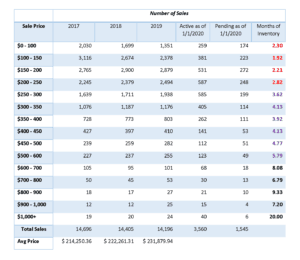How did we do in 2019?
My favorite part of real estate: the numbers! You may remember the analyses I’ve put together throughout 2019: January 2019, April 2019, July 2019, and October 2019. Now that we’ve finished off 2019, it’s time to see how the Des Moines housing market did.
As in the past few years, you may have heard that “it’s a great time to sell!”, which means that we have less than 3 months of inventory available to buy (i.e., we have less houses for sale than would normally sell in 3 months). Also, as in the past few years, this is still true, but only for some segments. Depending on the price range, we could be in a seller’s market (marked in red), a balanced market (marked in purple), or a buyer’s market (marked in black). Check out the numbers below.

This is what I’m seeing with this data:
- The average price has continued to appreciate, rising 4.3% since 2018. It should stay below 5% from year to year for the next few years.
- The number of homes sold was slightly higher in 2018 vs. 2019.
- The price ranges in the seller’s market, balanced market, and buyer’s market has stayed pretty steady year over year.
Overall, we have a balanced market across all segments. However, based on the price, the months of inventory available varies dramatically. We have a seller’s market until about $250,000, then we have a balanced market through $600,000, and then we have a buyer’s market. There are a few reasons for this change in market statistics:
- New construction is typically not available for the lower price ranges, which limits inventory.
- There are fewer people who are purchasing in higher price points, which limits the number of houses sold at those price points each year.
What Can We Expect in 2020?
Mortgage interest rates are back into historical lows, but I have not seen a significant increase in buyer activity due just to these interest rates (although refinancing numbers are way up). We should still see a seller’s market for the lower priced homes, but overall, homes above $200,000 are sitting just a bit longer on the market.
Rents are continuing to rise, which should encourage more first-time homebuyers into the market. Builders are responding to the need for new construction at entry-level prices, building developments in Norwalk, Elkhart, Pleasant Hill, and beyond.
Lenders continue to introduce programs requiring lower down payments (as low as 0%), to help first-time homebuyers purchase if needed. Keep in mind, the less that you put down on a mortgage, the longer you will need to stay in order to build up equity in your home and not end up underwater.
What Does This Mean to Me?
First, keep in mind that real estate markets are highly segmented. The state of your specific market depends heavily on your neighborhood (not even your town), the size of your house and the houses around you, and the condition of your home. The numbers above summarize Des Moines and surrounding areas overall but may not apply to you directly.
- If you’re thinking about buying a home in 2020, let’s do it. Interest rates are still historically low, and experts are predicting that they won’t stay this low forever.
- If you’re not ready to make a move at all, then these ebbs and flows of the market do not affect you. Keep up with your home maintenance, or working on your credit, or all of the above, if you’re looking to make a move in the future.
While the numbers above may give you an idea of what to expect, if you are thinking about making a move, contact us, and we can discuss your situation in more detail, so you can either get the most money for selling your house or buy a new house for the right price (or both)!
* Sales prices in thousands. This data includes all residential properties in the Multiple Listing Service (MLS) for the Des Moines Area Association of Realtors (DMAAR). For Sale By Owner homes may not be included.
** Seller’s markets are those with 0-3 months of inventory. Balanced markets are those with 3-6 months of inventory. Buyer’s markets are those with 6+ months of inventory.



